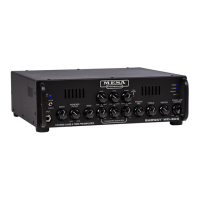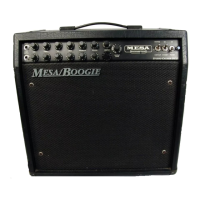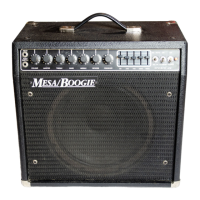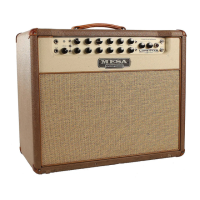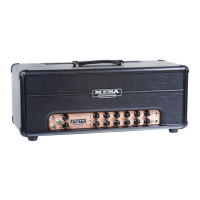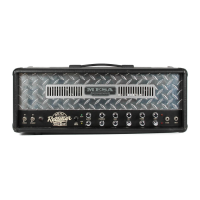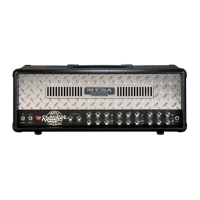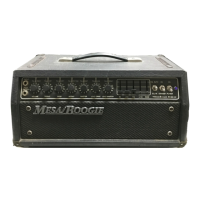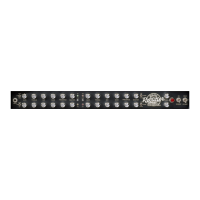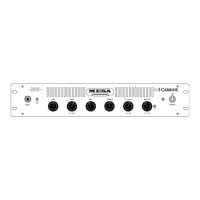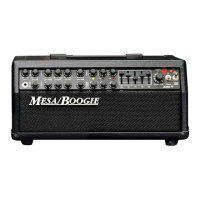can help to narrow down the problem, as the headphone signal is derived post-power amp using a frequency compensated, cabinet
emulation network.
LIMIT LED:
This amber LED indicates that the power amp is nearing maximum power and is entering the soft clip/limit output
tube emulation mode. Soft clip/limit output tube emulation mode mimics many of the desirable characteristics of tube amp output stage
overdrive (like soft clip character, damping, symmetry, recovery) while eliminating the common solid state clipping artifacts. There is
approximately 6dB of range on this circuit, driving beyond this, of course, will cause gradual output stage clipping. It’s acceptable for this
amplifier to operate in output stage overdrive mode (if that’s the tone you are after) with the LED flashing roughly 25% of the time on.
REAR PANEL (CONTROLS & FEATURES)
POWER SWITCH:
This switch is used to turn your amp on and off by disconnecting the amplifier from the power source
(mains). This amplifier complies with the EU Eco-design directive by providing a switched “0.00 watt power consumption off-mode”.
Note that there is protection circuitry built in that prevents the amp from starting up multiple times within a 20 second window. If you
turn the amp on, then off the on again, there will be ~20 second delay in the power-up sequence.
IEC POWER INLET:
This power inlet conforms to the IEC C-14 type standard, and is to be used with a cordset containing a
matching connector, and appropriate plug for the intended market.
OPERATING POWER REQUIREMENTS:
The SUBWAY TT-800 is designed with a universal, auto-ranging power supply
that automatically adjusts to line voltages between 100-120V and 220-240V, 50 or 60Hz. The power supply is internally monitored
by supervisory protection circuits and thus contains a non-user replaceable fuse that opens in the unlikely event of a major failure.
The amplifier is designed to be used with grounded or earthed power, meaning that the chassis is always maintained at ground/earth
potential even in the event of a gross failure within (or external to) the amplifier. Never remove the grounding/earthing pin from the
power plug, or alter the power cable.
COOLING FAN:
The SUBWAY TT-800 incorporates a low speed, high reliability cooling fan which allows it to drive stressful loads
(including 2 ohms) at very high duty cycles. Be sure the fan’s inlet and head’s vent slots are not blocked or the amplifier’s protection
circuits will shut the amplifier down due to a thermal fault condition. This quiet, low noise fan will always run at a low speed, the air
flows into the chassis from the back and out through the front and side slot vents.
SPEAKER OUTPUTS:
The SUBWAY TT-800 is rated to drive a minimum 2 ohm load (with the impedance selector switch set
to the 2 ohm position), meaning either 4 x 8 ohm cabinets or 2 x 4 ohm cabinets. The amplifier incorporates a pair of SpeakOn™
NL4FC connectors wired in parallel that mate with either NL2MP or NL4MP plugs. The IMPEDANCE SELECTOR SWITCH needs
to be set to the combined speaker load connected to the amp.
Cables using NL-2 plugs contain only 1+/1- terminals and will always be correctly wired for use with the amplifier, but cables using NL4
connectors come with different wiring configurations. If using cables with NL-4 connectors, they may be constructed with standard 2
wire cable which must be wired 1+ to 1+ and 1- to 1-. If the cable contains 4 wires, that’s ok because terminals 2+ and 2- which are
connected to the second pair are simply not used.
The cables to avoid are what are called NL4 bridge mode cables, which are typically 2 wire, and wired 1+/1- on the speaker end and
1+/2+ on the amplifier end (used for pro audio power amps that support this specific bridged termination). These cables SHOULD be
clearly marked but sometimes they are not, so be aware of the possibility when buying or troubleshooting cables.
Why SpeakOn™ cables and not the “old favorite” ¼” (6.35mm) connector? There are several important reasons, the first being that
with updates to global safety regulations, amplifiers like the Subway TT-800 require “touch-proof connections”. A second reason is
because the power amplifier’s internal topology is BTL (bridge tied load), neither output terminal are at ground potential, so touch-proof
connectors provide an added layer of safety to the system. A third reason is the often poor quality of the 1/4” (6.35mm) connection,
which at low power is not much of an issue, but at higher power levels become a potential failure point. A fourth reason is that one
common failure mode of amplifiers is when the 1/4” (6.5mm) speaker cable works loose at the speaker cabinet, the tip gets shorted to
the sleeve within the speaker jack’s bushing, applying a short circuit to the amplifier’s speaker output. While this amplifier is protected
PAGE 9
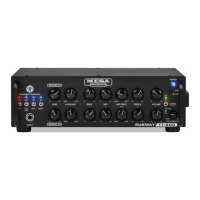
